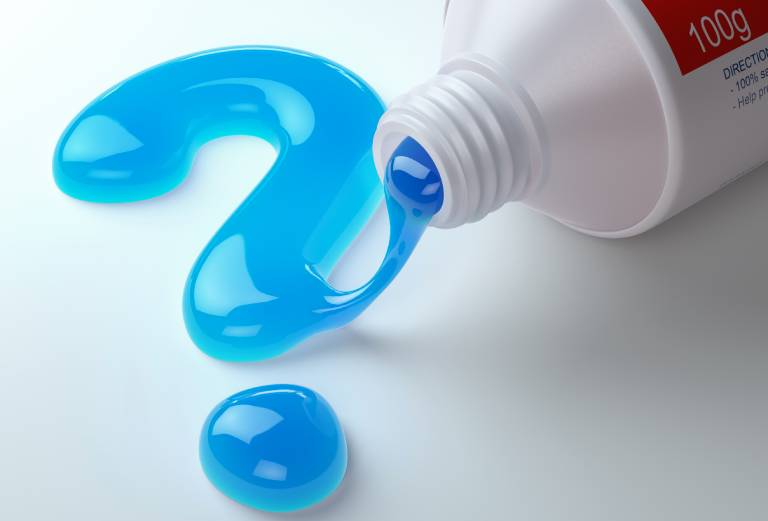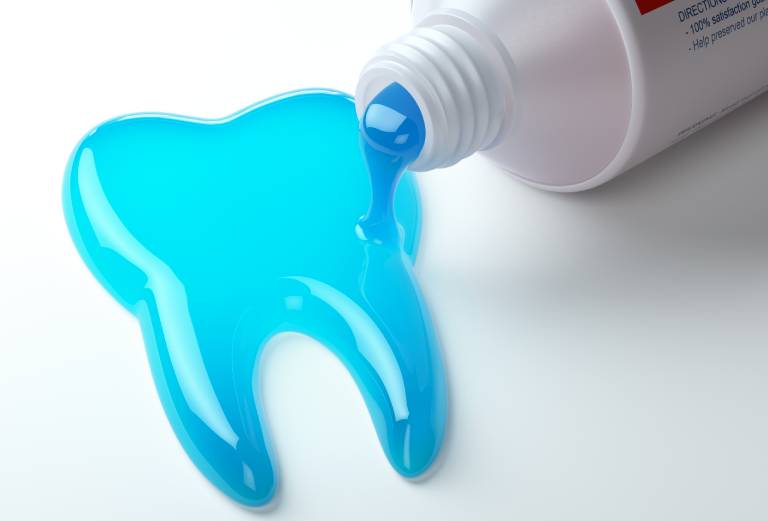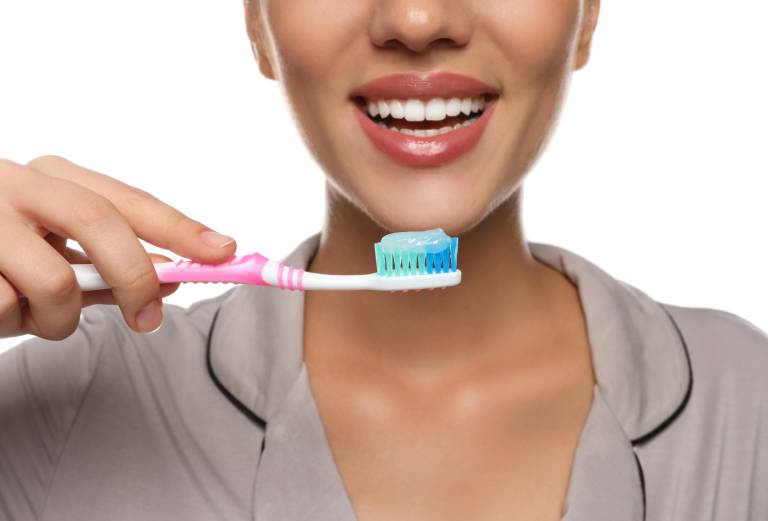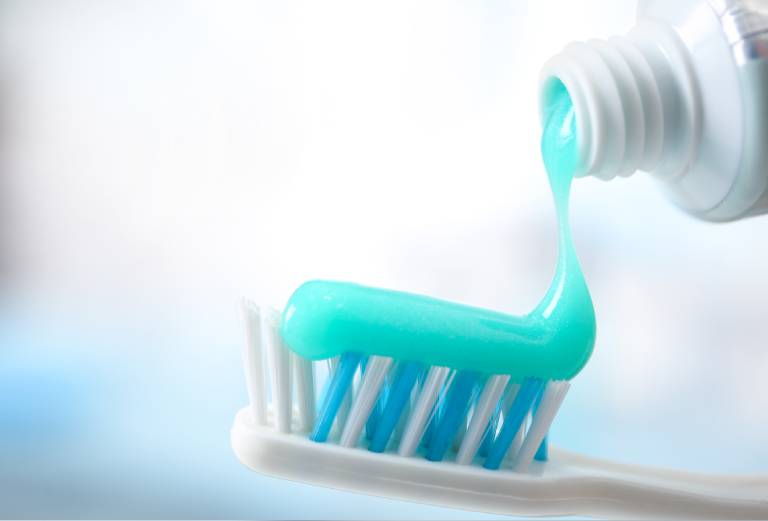Menu
What toothpaste should I use?
Understanding what toothpaste to use is a very common question.
With so many choices how do you know which one to choose?
And how do you know which toothpaste is right for your teeth?
In this guide, we are going to walk you through everything you need to know about toothpaste.
We’ll tell you:
- What exactly is toothpaste
- Why it’s important to choose the right kind
- Different types of toothpaste
- How to choose the right toothpaste for you
Let’s jump right in!
 What Is Toothpaste?
What Is Toothpaste?
Toothpaste is a paste or gel dentifrice used with a toothbrush to clean and maintain the aesthetics and health of teeth.
Toothpaste is used to promote oral hygiene: it is an abrasive that aids in removing dental plaque and food from the teeth, assists in suppressing halitosis, and delivers active ingredients (most commonly fluoride) to help prevent tooth decay (dental caries) and gum disease (gingivitis).
Owing to differences in composition and fluoride content, not all toothpastes are equally effective in maintaining oral health.
Toothpastes are derived from a variety of components, the three main ones being abrasives, fluoride, and detergent. Abrasives constitute 8-20% of a typical toothpaste. Common abrasives include calcium carbonate, dehydrated silica gels, and hydrated aluminum oxides.

These ingredients scrub and polish the surface of the teeth without damaging your tooth’s enamel.
Fluoride is the most important ingredient in toothpaste. Fluoride helps to strengthen tooth enamel and prevent cavities. All toothpastes should contain fluoride, especially for children and adults at high risk of cavities.
Surfactants, such as sodium lauryl sulfate (SLS), are also commonly used in toothpastes. Surfactants help to create foam and remove plaque and food particles from the teeth.
Other ingredients that may be found in toothpastes include:
- Humectants: These ingredients help to retain moisture and prevent the toothpaste from hardening.
- Flavorings: These ingredients give the toothpaste a pleasant taste.
- Sweeteners: These ingredients may be used to make the toothpaste more palatable, but they are not necessary and may not be suitable for everyone.
- Anti-bacterial agents: These ingredients may be used to help reduce plaque and gingivitis.
-
Tartar control agents: These ingredients may be used to help prevent tartar from forming on the teeth.
 Why Is It Important to Choose The Right Toothpaste?
Why Is It Important to Choose The Right Toothpaste?
Choosing the right toothpaste is important for maintaining good oral health. Toothpaste can help to clean your teeth, remove plaque, prevent cavities, and freshen your breath.
Toothpaste isn’t just about flavor and aesthetics; it plays a crucial role in preventing dental issues and promoting overall well-being.
Additionally, toothpaste tailored to specific needs, such as sensitivity or gum health, can address individual oral concerns effectively.
By selecting the appropriate toothpaste, individuals can ensure that their daily oral hygiene routine supports the prevention of dental problems, the maintenance of fresh breath, and the preservation of a bright, confident smile.
Ultimately, making an informed choice when it comes to toothpaste is an integral part of a proactive approach to oral care and overall health.
Here are some of the reasons why it is important to choose the right toothpaste:
To prevent cavities: Fluoride is the most important ingredient in toothpaste for preventing cavities. Fluoride helps to strengthen tooth enamel and make it more resistant to acid attacks from bacteria.
To remove plaque: Plaque is a sticky film of bacteria that forms on your teeth. Plaque can lead to cavities and gum disease if it is not removed regularly. Brushing your teeth with the right toothpaste can help to remove plaque and keep your teeth clean and healthy.
To freshen your breath: Toothpaste can help to freshen your breath by removing food particles and bacteria from your mouth. Some toothpastes also contain ingredients that can help to fight bad breath.
To address specific oral health concerns: There are toothpastes available that are specifically designed to address specific oral health concerns, such as sensitive teeth, tartar buildup, and gum disease. If you have any of these concerns, talk to your dentist about the best toothpaste for you.
 Different Types of Toothpaste
Different Types of Toothpaste
There are many different kinds of toothpaste available, each with its own unique benefits. Here are some of the most common types:
Fluoride toothpaste: This is the most common type of toothpaste and is recommended by dentists for most people. Fluoride helps to strengthen tooth enamel and prevent cavities.
Sensitive teeth toothpaste: This toothpaste is designed for people with sensitive teeth and gums. It contains ingredients that help to reduce pain and sensitivity.
Whitening toothpaste: This toothpaste contains ingredients that help to remove surface stains from teeth, making them appear whiter.
Anti-plaque toothpaste: This toothpaste contains ingredients that help to remove plaque, a sticky film of bacteria that can lead to cavities and gum disease.
Anti-tartar toothpaste: This toothpaste contains ingredients that help to prevent tartar from forming on teeth. Tartar is a hardened form of plaque that can irritate gums and lead to gum disease.
Children’s toothpaste: Children’s toothpaste typically contains less fluoride than toothpaste designed for adults. This is because children are more likely to swallow toothpaste, and too much fluoride can be harmful.
Herbal toothpaste: This toothpaste is made with natural ingredients, such as herbs and essential oils. Some people prefer herbal toothpaste because they avoid the use of artificial ingredients.
In addition to these general categories, there are also many other types of toothpaste available, such as toothpaste for smokers, toothpaste for people with braces, and toothpaste for people with dry mouth.
 How to Choose the Right Toothpaste for You
How to Choose the Right Toothpaste for You
When choosing a toothpaste, it is important to look for one that has the American Dental Association (ADA) Seal of Acceptance. This seal means that the toothpaste has been evaluated by the ADA and found to be effective and safe.
You should also choose a toothpaste that is right for your individual needs. Talk to Dr. Harrell about the best toothpaste for you based on your oral health and any specific concerns you may have.
Here are some quick tips for choosing the right toothpaste:
- Look for a toothpaste that has the ADA Seal of Acceptance.
- Choose a toothpaste that contains fluoride.
- Consider your specific oral health needs. If you have sensitive teeth, tartar buildup, or gum disease, there are toothpastes available that are specifically designed to address these concerns.
- Talk to your dentist about the best toothpaste for you.

Look for a toothpaste that contains fluoride.
Choose a toothpaste with the right level of abrasiveness. Toothpastes with a high level of abrasiveness can wear away tooth enamel over time. If you have sensitive teeth, choose a toothpaste with a low level of abrasiveness.
Consider your other oral health needs. If you have sensitive teeth, gums, or dry mouth, there are toothpastes available that are specifically designed to address these concerns. For example, sensitive teeth toothpaste contains ingredients that help to reduce pain and sensitivity, while dry mouth toothpaste contains ingredients that help to keep your mouth moist.
Avoid toothpastes that contain harsh ingredients. Some toothpastes contain ingredients such as sodium lauryl sulfate (SLS) and triclosan, which can irritate your gums and teeth. If you have sensitive teeth or gums, look for a toothpaste that is SLS-free and triclosan-free.
Consider your personal preferences. Toothpastes come in a variety of flavors and textures. Choose a toothpaste that you enjoy using so that you are more likely to stick to your daily brushing routine.
Popular Brands of Toothpaste:
- Colgate: Colgate is one of the most popular toothpaste brands in the world. It offers a wide variety of toothpaste products to meet the needs of different people, including:
- Colgate Cavity Protection Toothpaste: This toothpaste is designed to help prevent cavities.
- Colgate Total Toothpaste: This toothpaste is a multi-benefit toothpaste that helps to prevent cavities, fight plaque and tartar, freshen breath, and whiten teeth.
- Colgate Optic White Toothpaste: This toothpaste is designed to whiten teeth.
- Colgate Sensitive Toothpaste: This toothpaste is designed for people with sensitive teeth and gums.
- Crest: Crest is another popular toothpaste brand. It also offers a wide variety of toothpaste products to meet the needs of different people, including:
- Crest Pro-Health Toothpaste: This toothpaste is designed to help prevent cavities, fight plaque and tartar, freshen breath, and whiten teeth.
- Crest 3D White Toothpaste: This toothpaste is designed to whiten teeth.
- Crest Gum Detoxify Toothpaste: This toothpaste is designed for people with gum disease.
- Crest Sensi-Stop Toothpaste: This toothpaste is designed for people with sensitive teeth.
- Sensodyne: Sensodyne is a toothpaste brand that is specifically designed for people with sensitive teeth. It offers a variety of toothpaste products to help reduce tooth sensitivity, including:
- Sensodyne Pronamel Toothpaste: This toothpaste is designed to strengthen enamel and reduce tooth sensitivity.
- Sensodyne Sensitive Teeth Toothpaste: This toothpaste is designed to provide relief from tooth sensitivity.
- Sensodyne Rapid Relief Toothpaste: This toothpaste is designed to provide fast relief from tooth sensitivity.
Other popular toothpaste brands include:
- Arm & Hammer
- Aim
- Close-Up
- Parodontax
- Aquafresh
 Best Way to Use Toothpaste Effectively
Best Way to Use Toothpaste Effectively
- Apply a pea-sized amount of toothpaste to your toothbrush. This is enough toothpaste to clean your teeth effectively without using too much.
- Brush your teeth for two minutes, twice a day. Be sure to brush all surfaces of your teeth, including the front, back, and top.
- Pay special attention to hard-to-reach areas, such as the backs of your molars and your gum line.
- Spit out the toothpaste after brushing. You do not need to rinse your mouth with water. This will help the fluoride to stay on your teeth and protect them from cavities.
Additionally Keep These Things in Mind:
- Use a soft-bristled toothbrush. Hard-bristled toothbrushes can damage your teeth and gums.
- Replace your toothbrush every three to four months, or sooner if the bristles are frayed or damaged.
- Brush your tongue. This will help to remove bacteria and freshen your breath.
- Floss your teeth once a day. Flossing helps to remove plaque and food particles from between your teeth where your toothbrush cannot reach.
Choosing the right toothpaste is important for maintaining good oral health. When choosing a toothpaste, be sure to consider your individual needs and oral health goals.
Talk to Dr. Harrell during your next dental checkup about the best toothpaste for you.

